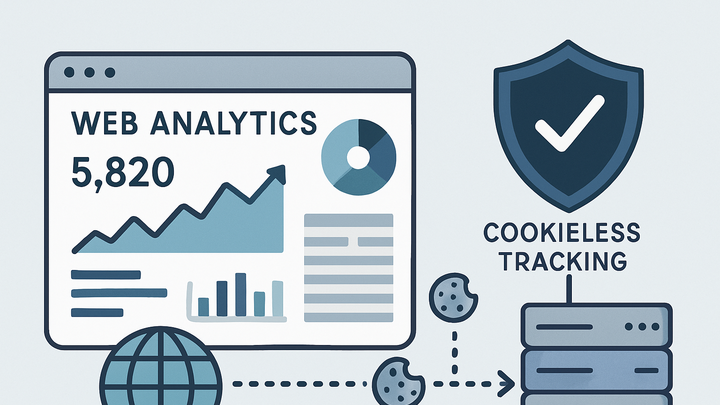Published on 2025-06-28T06:19:20Z
What is Privacy-first Analytics? Examples and Implementation
Privacy-first analytics is an approach to web and product measurement that minimizes or eliminates the collection of personal identifiers and third-party cookies. By focusing on aggregated, anonymized, and first-party contextual data, organizations can comply with privacy regulations like GDPR and CCPA, build user trust, and future-proof their analytics strategy against browser restrictions. Solutions like PlainSignal offer fully cookieless tracking, while platforms like Google Analytics 4 enable IP anonymization and consent mode. This article explores the core principles, methods, benefits, and real-world implementations of privacy-first analytics.
Privacy-first analytics
An analytics approach that prioritizes user privacy by minimizing personal data, using cookieless methods and anonymization.
Importance of Privacy-first Analytics
Privacy-first analytics is essential in today’s regulatory and technical landscape. With increasing legal requirements (GDPR, CCPA) and browsers phasing out third-party cookies, organizations must adopt methods that respect user privacy while still delivering actionable insights.
-
Regulatory compliance
Ensures data collection aligns with privacy laws like GDPR and CCPA, reducing legal risk and potential fines.
-
User trust
Minimizing personal data collection and being transparent about analytics practices fosters stronger relationships and higher opt-in rates.
-
Future-proofing analytics
With third-party cookies being deprecated, adopting cookieless and privacy-centric methods guarantees continued access to key metrics.
Core Principles of Privacy-first Analytics
Privacy-first analytics is guided by a few foundational principles that govern how data is collected, processed, and stored.
-
Data minimization
Collect only the metrics essential for business goals, avoiding unnecessary personal identifiers.
-
Anonymization
Transform or aggregate data so that individual users cannot be re-identified.
-
User transparency & consent
Clearly inform users about what is tracked and obtain explicit consent where required.
How Privacy-first Analytics Works
By leveraging cookieless tracking techniques and first-party contexts, privacy-first analytics platforms deliver insights without personal data.
-
Cookieless tracking
Uses browser APIs (e.g., localStorage, memory) or server-side event ingestion instead of third-party cookies.
-
Aggregated metrics
Reports data in aggregates (totals, averages) to prevent linking back to individual users.
-
Contextual data
Relies on non-personal contextual signals (page URL, referrer, device type) for segmentation.
-
Consent management
Integrates with consent banners to respect user preferences before firing any tracking requests.
Implementation Examples: PlainSignal and GA4
Below are code examples showing how to integrate two popular analytics solutions in a privacy-first manner.
-
PlainSignal integration
PlainSignal is a fully cookieless, GDPR-compliant analytics tool. Add this snippet to your
<head>to start collecting aggregated metrics without cookies:<link rel="preconnect" href="//eu.plainsignal.com/" crossorigin /> <script defer data-do="yourwebsitedomain.com" data-id="0GQV1xmtzQQ" data-api="//eu.plainsignal.com" src="//cdn.plainsignal.com/plainsignal-min.js"></script>-
Domain preconnect
The
<link rel="preconnect">hint establishes an early connection to PlainSignal’s CDN, reducing latency. -
Script configuration
data-dospecifies your domain,data-idis your project token, anddata-apisets the endpoint for event ingestion.
-
-
Google analytics 4 integration
GA4 supports IP anonymization and consent mode to limit personal data collection. Insert this snippet in your
<head>:<script async src="https://www.googletagmanager.com/gtag/js?id=G-XXXXXXX"></script> <script> window.dataLayer = window.dataLayer || []; function gtag(){dataLayer.push(arguments);} gtag('js', new Date()); gtag('config', 'G-XXXXXXX', { 'anonymize_ip': true }); </script>-
Gtag.js loader
The async
<script>tag loads the GA4 library without blocking page rendering. -
Ip anonymization
The
anonymize_ipparameter masks the user’s IP address, enhancing privacy.
-
Benefits and Challenges
Adopting privacy-first analytics brings many advantages but also some trade-offs that organizations should consider.
-
Enhanced user trust
Respecting privacy builds goodwill, leading to higher engagement and opt-in rates.
-
Regulatory alignment
Streamlines compliance with GDPR, CCPA, and other data protection laws.
-
Reduced granularity
Aggregated and anonymized data may limit deep, individual-level analysis.
-
Implementation complexity
Switching to new tracking paradigms can require development effort and process updates.
